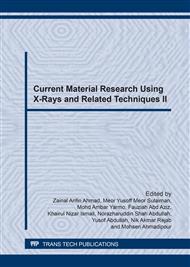[1]
S. Cetinkaya, S. Eroglu, Thermodynamic analysis and reduction of tungsten trioxide using methane, Int . J. of Refrac, Metals and Hard Mater. 51 (2015) 137–140.
DOI: 10.1016/j.ijrmhm.2015.03.017
Google Scholar
[2]
C. Y. Su, Z. K. Yang, H. C. Lin, C. K. Lin, C. H. Chang, N. Taipei, Tungsten oxide nanopowders and nanorods prepared by a modified plasma arc gas condensation technique, NSTI-Nanotec. 4 (11) (2007) 261–264.
DOI: 10.2320/matertrans.m2009068
Google Scholar
[3]
C.Y. Su, H.C. Lin, T.K. Yang, C.H. Chang, C.K. Lin, Tungsten oxide nanopowders and nanorods prepared by a modified plasma arc gas condensation technique, Mater. Trans. 50 (11) (2009) 2593–2597.
DOI: 10.2320/matertrans.m2009068
Google Scholar
[4]
J. Dang, G. Zhang, K. Chou, Study on kinetics of hydrogen reduction of MoO2, Int . J. Refract. Met. Hard Mater. Stud. 41 (2013) 356–362.
Google Scholar
[5]
M.I. Zaki, N.E. Fouad, S.A.A. Mansour, A.I. Muftah, Temperature-programmed and x-ray diffractometry studies of hydrogen-reduction course and products of WO3 powder: Influence of reduction parameters, Thermochim. Act. 523 (2011) 90–96.
DOI: 10.1016/j.tca.2011.05.004
Google Scholar
[6]
F. Salleh, A. Samsuri, M. Wahab, M. Hisham, M.A. Yarmo, Temperature-programmed and x-ray diffractometry studies of WO3 reduction by carbon monoxide, Adv. Mater. Res. 1087 (2015) 73–76.
DOI: 10.4028/www.scientific.net/amr.1087.73
Google Scholar
[7]
D. S. Venables, M.E. Brown, Reduction of tungsten oxides with carbon monoxide, Thermochim. Act. 291 (1997) 131-140.
DOI: 10.1016/s0040-6031(96)03068-7
Google Scholar
[8]
G.S. Kim, Y.J. Lee, D.G. Kim, S.T. Oh, D.S. Kim, Y. Do Kim, The behavior of tungsten oxides in the presence of copper during hydrogen reduction, J. Alloys Compd. 419 (2006) 262–266.
DOI: 10.1016/j.jallcom.2005.09.061
Google Scholar
[9]
S. Damyanova, B. Pawelec, K. Arishtirova, M.V.M. Huerta, J.L.G. Fierro, Study of the surface and redox properties of ceria–zirconia oxides, Appl. Catal. A Gen. 37 (2008) 86–96.
DOI: 10.1016/j.apcata.2007.12.005
Google Scholar
[10]
Z. Ma, D. Weng, X. Wu, Z. Si, Effects of WOx modification on the activity , adsorption and redox properties of CeO2 catalyst for NOx reduction with ammonia, J. of Env. Sci. 24 (7) (2012) 1305-1316.
DOI: 10.1016/s1001-0742(11)60925-x
Google Scholar
[11]
H. Wen, T. Dunqiang, L. Yalei, Y. Xi, L. Lei, L. Deping, Effect of CeO2 on the thermoelectric properties of WO3-based ceramics, J. of Rare Eart. 33 (5) (2015) 561-566.
Google Scholar
[12]
H. Wang, Z. Hua, S. Peng, X. Dong, L. Dong, Y. Wang, Effect of CeO2 on the thermoelectric properties of WO3-based ceramics, Ceram. Int. 38 (2012) 1133–1137.
DOI: 10.1016/j.ceramint.2011.08.041
Google Scholar


